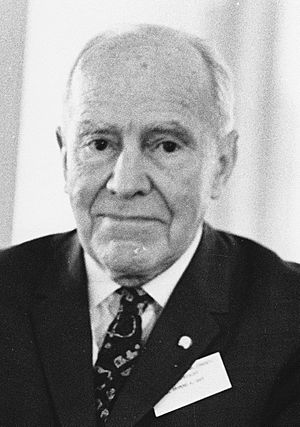Raymond Dart facts for kids
Quick facts for kids
Raymond Arthur Dart
|
|
|---|---|

Dart in 1968
|
|
| Born | 4 February 1893 |
| Died | 22 November 1988 (aged 95) Johannesburg, South Africa
|
| Nationality | Australian |
| Alma mater | Ipswich Grammar School, University of Queensland, University of Sydney |
| Known for | Australopithecus africanus |
| Spouse(s) |
Dora Tyree
(m. 1921; div. 1934)Marjorie Frew
(m. 1936) |
| Awards | Viking Fund Medal (1957) |
| Scientific career | |
| Fields | anatomist, anthropologist |
Raymond Arthur Dart (born 4 February 1893 – died 22 November 1988) was an Australian anatomist and anthropologist. He is most famous for discovering the first fossil of Australopithecus africanus in 1924. This was an extinct hominin, which means it was an early human ancestor. He found this important fossil at Taung in the North West province of South Africa.
Contents
Early Life and Education
Raymond Dart was born in Toowong, a suburb of Brisbane, Queensland, Australia. He was the fifth of nine children. His father was a farmer and a tradesman. Raymond's birth happened during a big flood in Brisbane in 1893.
He went to Toowong State School and Blenheim State School. From 1906 to 1909, he attended Ipswich Grammar School on a scholarship. Raymond first wanted to study medicine and become a medical missionary. However, his father encouraged him to study science at the new University of Queensland.
He was among the first students at the university in 1911. He studied geology and zoology, earning his BSc in 1913. He then became the first student to graduate with honours from the University of Queensland in 1914. He received his MSc with honours in 1916. Later, he studied medicine at the University of Sydney, getting his MB and M.Surgery degrees in 1917. He earned his M.D. from the University of Sydney in 1927.
War Service and Early Career
During the last year of World War I, Dart served as a captain and medic in the Australian Army. He worked in England and France.
After the war, he worked at the University College, London starting in 1920. This was thanks to Grafton Elliot Smith, a famous anatomist and fellow Australian. He then spent a year in the United States on a special fellowship. In 1922, he moved to Johannesburg, South Africa. He became a Professor at the new anatomy department at the University of the Witwatersrand.
Discovering Early Human Ancestors
In 1924, Raymond Dart made his most famous discovery. He found the first Australopithecus africanus fossil. This was an extinct hominin closely related to humans. His colleague, Professor Robert Burns Young, sent him two crates of fossils. These came from the small town of Taung in the North West Province of South Africa.
When Dart saw the fossils, he quickly realized one was an early human. Its brain size was too big for a baboon or chimpanzee. This child's skull was found with other fossilized animals.
At first, other scientists did not believe Dart's findings. This was because he was not part of the main scientific group. Also, he found the fossil in Africa, but many scientists thought humans came from Europe or Asia.
Support and Recognition
Robert Broom became Dart's closest supporter. Broom found more Australopithecine fossils, which proved Dart was right. Eventually, in 1947, Sir Arthur Keith, a well-known scientist, admitted he was wrong. He said, "...Dart was right, and I was wrong." Keith had doubted Dart's idea that the 'Taung Child' was an early human ancestor.
Some of Dart's ideas were also made popular by the writer Robert Ardrey. This happened through articles and a series of books, starting with African Genesis in 1961.
However, not all of Dart's theories were proven correct over time. Some of his ideas have been questioned. His early work was greatly influenced by his mentors, especially Grafton Elliot Smith.
Personal Life
Raymond Dart married Dora Tyree, a medical student, in 1921. They later divorced in 1934. In 1936, he married Marjorie Frew. She was the head librarian at the University of Witwatersrand in Johannesburg. They had two children, Tiara and Galen.
Legacy and Later Work
The Institute for the Study of Man in Africa was created in 1956 to honour Raymond Dart. The first Raymond Dart Memorial Lecture was held there in 1964.
Dart was the director of the School of Anatomy at the University of the Witwatersrand, Johannesburg, until 1958. He worked with Phillip Tobias, who continued his studies of the Cradle of Humankind. In 1959, Dart wrote a book about his discoveries called Adventures with the Missing Link. In this book, he thanked Josephine Salmons, his first female student. She told him about a fossilized baboon skull that led to the discovery of the 'Child skull of Taung'.
When he was 73, Dart started spending time in South Africa and with an organization called The Institutes for the Achievement of Human Potential (IAHP). This group helps children with brain injuries. Dart's son, Galen, had suffered motor damage at birth. Raymond Dart worked with the IAHP for about twenty years. He passed away in Johannesburg in 1988.
Works
- Dart R.A. (1925): Australopithecus africanus: The Man-Ape of South Africa. Nature, Vol.115, No.2884 (1925) 195-9.
- Dart, Raymond A. and Craig, Dennis (1959): Adventures with the Missing Link. New York: Harper & Brothers (autobiography).
See also
 In Spanish: Raymond Dart para niños
In Spanish: Raymond Dart para niños
- Dawn of Humanity (2015 PBS film)
- Hominidae
- Human evolution
- List of fossil sites
- List of hominina fossils
- Prehistoric warfare


